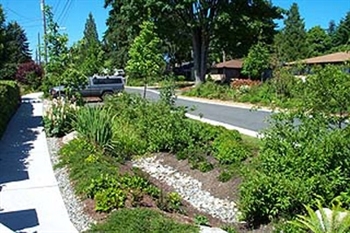
Jason Berry
Flooding in the Calumet region (here, in Blue Island in summer of 2014) will require integrated technological, ecological, social and policy solutions.
 By Former MPC Project Manager Abby Crisostomo
By Former MPC Project Manager Abby Crisostomo - November 5, 2014
After several months of setting the stage for collaboration through prioritizing goals, the Calumet Stormwater Collaborative is diving into the details of how stormwater management decisions are really made in the Calumet region. At the October meeting of the Collaborative, we learned about the intricacies of how the City of Chicago—both the Department of Water Management and the Department of Planning and Development—and the South Suburban Mayors and Managers Association—the Council of Government for the suburban communities in Calumet—make data-driven decisions for place-based stormwater investments. For a detailed description of what happened at the meeting, read the summary here.
Dealing with stormwater is complex: not only the technical aspects, but also the wide range of problems, variables, sources, funding mechanisms, definitions, players and impacts, as well as how those relate to the many possible solutions. While data analysis is central to how we understand the impacts of stormwater, as one might expect, the approaches are much more complex, requiring more than just technological innovation. The three presenters showed three different approaches to obtaining, analyzing, visualizing and applying data to help determine site-specific stormwater investments, both grey and green. From the Dept. of Water Management’s complex hydrologic and hydraulic model of the city’s sewer system to the Dept. of Planning and Development’s use of remote sensing technology to map changes in elevation that influence how water flows over the ground to the South Suburban Mayors and Managers Association GIS consortium’s mapping of flooding problem areas based on local expertise, local agencies are still testing different approaches and trying to identify the best mechanisms for informed decision-making. The common thread between these varied approaches is how they are executed on the ground.

Is it stormwater infrastructure, or a community enhancement, or an urban respite? It's all of them.
As Collaborative members brainstormed how the technical tools presented at the meeting can intersect with other efforts, the overriding emphasis was on what many people call social infrastructure. In stormwater, we spend a lot of time talking about or debating the merits of grey and green infrastructure and the various new technologies to support either, but what members of the Collaborative have focused in on is the non-physical infrastructure that has to be in place to solve complex, regional problems like stormwater. It’s not enough to focus only on getting pipes and plants in the ground; it’s the social infrastructure—from workforce to politics to funding streams to awareness to local policies to research to collaboration—that leads to progress. While Chicago and its suburbs get a handle on data, through the Collaborative, they are also examining better ways to work with partners on data collection project execution, secure joint funding streams and coordinate with other organizations to share expertise, methods and information.
How the information is used is what ultimately matters, like the example of the Dept. of Planning and Development incorporating flow path information into their typical mapping tools and better integrating stormwater and planning decisions. When a developer comes to them with a real estate development proposal, the department uses the flow path data paired with local neighborhood plans to work with the developer on incorporating green infrastructure. An example of this is a recent proposal for affordable housing on 58th Street where it would be beneficial to redirect stormwater flow into nearby Washington Park. The next challenge is that of ensuring that the green infrastructure that does get installed is maintained properly, something that one of the Collaborative’s working groups—including representatives from Illinois-Indiana Sea Grant, OAI Inc., a workforce group, Center for Neighborhood Technology and others—is trying to tackle through training, volunteer corps and workforce development.
No doubt this bigger-picture, collaborative thinking is incredibly challenging. Engineers and scientists are learning that the ability to translate their highly technical expertise into something a lay decision-maker can understand might make or break progress on stormwater investments. Environmentalists and educators are learning that touting the many benefits of green infrastructure solutions without securing political will and funding will not get functional green infrastructure installed that truly alleviates stormwater problems. But while challenging, it brings together many different perspectives and gets people talking to each other, questioning each other’s methods and sharing ideas, resources and expertise toward a shared end goal.
MPC Program Director Josh Ellis manages the Calumet Stormwater Collaborative. He contributed to this post.